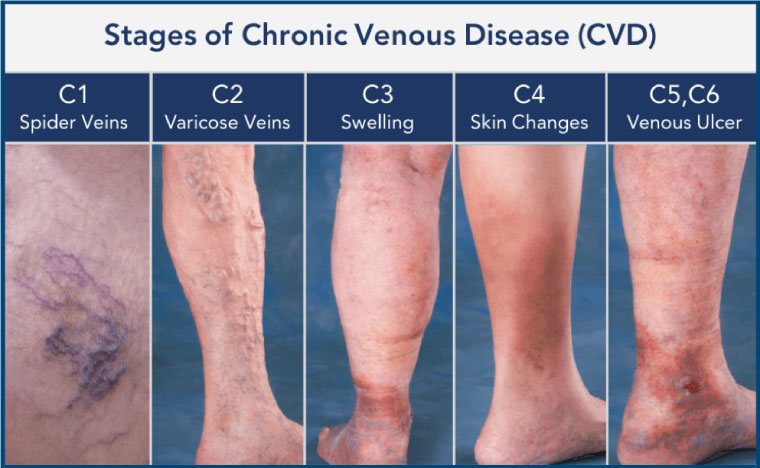Chronic venous insufficiency (CVI) occurs when the blood in your legs fails to flow back to your heart. This condition develops when either the vein walls or vein valves in the legs veins aren't functioning properly. Not enough blood flow in this part of the body often leads to a pooling effect known as "stasis", which can cause pain, lack of mobility, and related problems.
What Is Chronic Venous Insufficiency?
In normal conditions, the valves in your leg veins ensure a healthy amount of blood flow to your heart. CVI develops when these valves fail to function or your vein walls fail to work properly. In this situation, the blood is unable to flow to the heart and often falls backward to pool in the legs.
CVI shares some characteristics with lymphedema, with both conditions possibly involving the swelling of the feet and legs. There are many things known to cause CVI, including lifestyle factors, blood clots, and varicose veins.
Chronic Venous Insufficiency Stages and Types
Chronic venous insufficiency is a singular condition that often presents in three separate stages based on the type and severity of symptoms. While some patients will only experience symptoms associated with the first stage, others will experience all three stages over a period of time.
The more serious symptoms associated with this condition take time to develop, with lifestyle alterations and treatment both being useful in stopping or slowing CVI progression.
Chronic Venous Insufficiency Stages
- Stage 1 involves initial swelling, along with changes to the skin color and appearance.
- Stage 2 involves additional swelling, along with further pigmentation changes and dermatitis.
- Stage 3 involves swelling and symptoms from stages 1 and 2, with varicose veins and leg ulcers also developing.
CVI can go on to cause and influence other conditions, including abnormalities in the capillaries. This condition can lead to additional swelling, ulceration, and hyperpigmentation, with patches of skin becoming noticeably darker than usual.
Symptoms of Chronic Venous Insufficiency
CVI is associated with a range of symptoms, depending on the progression of the condition and the overall age and health of the patient.
- Pain associated with standing
- Swelling of legs and ankles
- Leg cramps
- Varicose veins
- Skin gets thicker and changes appearance
- Aching and throbbing sensations
- Leg ulcers
- Weakness in the legs and feet
- Tightness in the lower legs
Causes of Chronic Venous Insufficiency
CVI is associated with a number of risk factors including other health conditions, lifestyle factors, and family history.
- People who are overweight
- Pregnant women
- People who have damaged their leg due to injury or surgery
- People who have had previous blood clots
- Long periods of sitting or standing can cause high blood pressure in leg veins
- A sedentary lifestyle and lack of exercise
- Smoking
- Cancer
- Swelling of a superficial vein (phlebitis)
- A blood clot in a deep vein (deep vein thrombosis)
Chronic Venous Insufficiency Lifestyle Consequences
There are lifestyle consequences for people with CVI, mostly due to the pain and lack of mobility associated with this condition. While CVI is not a serious health threat itself, it can be disabling and disrupt regular physical activities. While exercise is a great way to manage and treat many CVI cases, the pain of this condition can make it hard for people to stand up for long periods or carry out certain movements.
What’s Next
Costs and Payment Options
The cost of treatment for CVI depends on the methods used, with most options ranging from $2000-$3000 for an 8-week course. According to a study published by the National Center for Biotechnology Information, the total expected treatment costs for CVI over an eight week period are:
- $2165 for polidocanol injectable foam
- $1827 for endovenous laser ablation
- $2106 for radiofrequency ablation
- $2374 for surgery
- $2844 for multimodality treatment
Many treatments for CVI are partially or completely covered by insurance providers, including but not limited to Medicare.
While this condition is not usually a serious health threat in isolation, it can be very painful and lead to a loss of movement and flexibility. CVI can be associated with other serious conditions, however, so it's important to see a doctor if you have a family history of CVI or any associated symptoms.
CVI is typically diagnosed with a medical examination, with a chronic venous insufficiency doctor also likely to look at your medical history. An imaging test called a Duplex Ultrasound is often used to analyze blood flow in the affected area, examine the overall structure of your leg veins, and check the speed and direction of blood flow in the blood vessel.
A thorough medical examination will be carried out prior to treatment, with options presented based on the expectations of your condition, how well you handle certain medications, and your own individual preferences. A chronic venous insufficiency doctor will create a tailored treatment plan based on your age and overall health condition, along with the extent and range of your presented symptoms.
If you would like to know more about chronic venous insufficiency from a leading vascular specialist, please contact our friendly support team at Vascular Health Centers today.
Accreditation & Awards, Memberships







